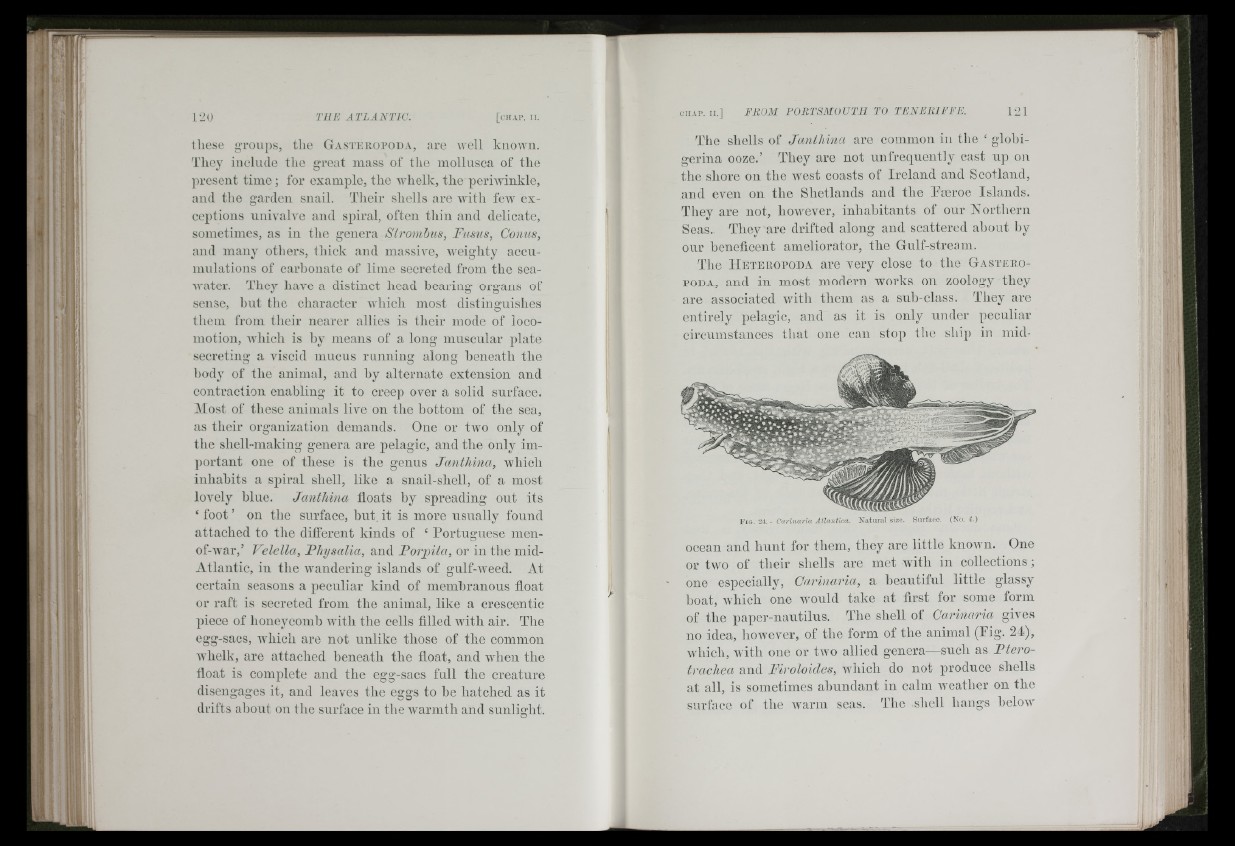
ii
I
120 T/ IE ATLANTIC. [ c h a p . 11.
these groups, tlie Gasteropoda, are avcII known.
They include the great mass of the mollusca of the
present time ; for example, the whelk, the periwinkle,
and the garden snail. Tlieir shells are Avitli few exceptions
univalve and spiral, often thin and delicate,
sometimes, as in the genera Siromhus, Fusus, Comis,
and many others, thick and massive, Aveiglity accumulations
of carbouate of lime secreted from the sea-
A\ ater. They have a distinct bead bearing organs of
sense, but the character Avliicli most distinguishes
them from their nearer allies is tlieir mode of locomotion,
which is by means of a long muscular plate
secreting a viscid mucus running along beneath the
body of the animal, and by alternate extension and
contraciion enabling it to creep over a solid surface.
Most of these animals live on the bottom of the sea,
as their organization demands. One or two only of
tbe shell-making genera are pelagic, and the only important
one of these is the genus Jantliina, which
inhabits a spiral shell, like a snail-shell, of a most
lovely blue. Janthina floats hy spreading out its
‘ foot ’ on the surface, hut. it is more usually found
attached to the different kinds of ‘ Portuguese men-
of-war,’ Velella, Fhysalia, and Forpita, or in the mid-
Atlantic, in the Avandering islands of gulf-Aveed. At
certain seasons a peculiar kind of membranous float
or raft is secreted from the animal, like a crescentic
piece of honeycomb Avith the cells filled Avith air. The
egg-sacs, Avhicli are not unlike those of the common
Avhelk, are attached beneath the float, and when the
float is complete and the egg-sacs full the creature
disengages it, and leaves the eggs to he hatched as it
drifts ahout on the surface in the Avarmth and sunligOht.
u iiA P . I I .] FROM RORTSMOUTl l TO TENERIFFE. 121
The shells of Janthina are common in the ‘ globigerina
ooze.’ They are not unfrequently cast np on
the shore on tbe Avest coasts of Ireland and Scotland,
and even on the Shetlands and the Pæroe Islands.
They are not, lioAvever, inhabitants of our Northern
Seas. They are drifted along and scattered about by
our beneficent ameliorator, the Gulf-stream.
The Heteropoda are very close to the Gasteropoda,
and in most modern Avorks on zoology they
are associated Avitli tlieni as a sub-class. They are
entirely pelagic, and as it is only under peculiar
circumstances that one can stop the ship iu mid-
F i g . 24. - C a r in a r ia A tla n tic a . N a tu ra l size. Surface. (N(j. 4.)
ocean and hunt for them, they are little knoAvn. One
or tAvo of tlieir shells are met Avitli in collections ;
one especially, Carinaría, a beautiful little glassy
boat, Avliich one Avould take at first for some form
of the paper-nantilus. Tbe shell of Carinaria gives
no idea, iioAvever, of tbe form of the animal (Pig. 21),
Avbicb, Avith one or tAvo allied genera—such as Ftero-
trachea and Firoloides, aaTiIcIi do not produce shells
at all, is sometimes abundant in calm Aveatber on the
surface of the Avarm seas. The shell hangs beloAV
Y; -V;
.li' ..j
I . ai.
! :::4Í
:, .
: i , > hh .
i 1
■
‘(ii'
i ;
li ■■
M
.'NI
i l